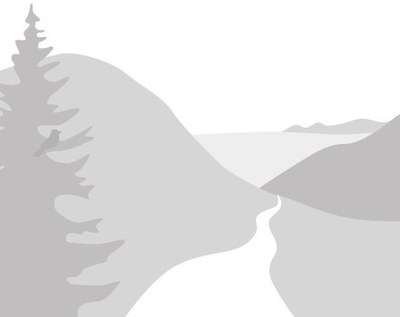
Trip Report
Pacific Crest Trail: Cady Ridge to Red Pass
- Mon, Sep 1, 2014
- Cady Ridge & Pacific Crest Trail
- Backpacking
AUGUST 28-30, 2014. With the fire closure of the Cady Ridge trail our BP group cast about for an alternative way to get up into the meadows on the west flank of Glacier Peak. I don't know how I had never stumbled across the Pilot Ridge trail before, but so glad I did! It sounded so good that we stayed with it for our 3-day backpack plan even after the Cady Ridge trail re-opened.
That's not to say that it was EASY. Far, far to the contrary. With no trouble finding our way to the well-marked North Fork Sauk trailhead, we set out through the huge trees and filtered sunlight for 1.9 miles on the N Fork Sauk trail to the (unsigned!!) junction to the Pilot Ridge trail on the right. (A sign on a big tree just past the jct reads 'Pacific Crest Trail' with an arrow.) Almost immediately the trail vanished into the river and we faced a crossing over a very well-placed log - not too high, nice and flat on top, no problem! From there the trail began to climb, and didn't quit for about 3 hours. The main 3.5 mile, 3000' switchback section featured one glimpse of Glacier Peak, its top shrouded in clouds, but mostly remained in forest and transitioned into more uphill, over several successive humps on the ridge.
Finally after about 4 hours we began to break out of the trees into meadows with views of Keyes, Monte Cristo and Sloan Peaks. From here the views were broad and flowers profuse, if a bit past prime. We began to see Johnson Mountain ahead, traversed the meadows around it, and finally descended steeply to Blue Lake on its south side. Blue Lake had a privy, a couple of good 3-tent-sized sites and multiple smaller ones around a pretty reflective lake. The camp area we chose looked out over a west-facing dropoff and our sunset payoff was dramatic. Though the nominal gain for our Pilot Ridge day was just 4000 feet, based on our GPS track we had actually done 5200 feet that day, over 11.6 miles.
After talking with others at the camp, we decided to take the 'high route' from Blue Lake up and over the ridge to Dishpan Gap, saving 2 miles. One fellow called it "brutal" which gave us some pause but we stayed with the plan and it proved no big deal - a bit steep but good clear switchbacks on both sides. We had reached Dishpan Gap and our old friend the PCT by about 10AM, and turned left to circle around Meander Meadow and Kodak Peak (no marked trail up Kodak, just a basic bootpath, but a straightforward though steep walk-up and great 360 views). From the point that we crossed the ridge above Blue Lake the day had been open meadows, and this pattern continued all the way to White Pass with the exception of a short forested section on both sides of Indian Pass. The lupine was profuse here, and even some fuschia-bright monkey flower by a spring.
Alas, by the time we had passed Reflection Pond to the west just beyond Indian Pass (with camps and fairly clean water), the clouds had lowered significantly and were beginning to drip on us. By the time we reached White Pass the valleys below were pretty well obscured. We had planned to set up camp at White Pass and dayhike up to Red Pass for views across to the White Chuck glacier, but no views were to be had and the weather was setting in in earnest. (Several good camps down below the trail at White Pass by the way, with a little sign to campsites and privy. Didn't see water but previous reports had said there was some down there.) So instead of setting up camp at 2PM only to hunker down in our tents, we decided to head on down the North Fork Sauk trail and camp near Mackinaw Shelter. The descent that looked so horrible on the map was really quite well graded and no problem. By 4PM we had found the shelter and set up in the spacious camps by the river nearby. Second day stats: another 11.5 miles and 3200' of gain.
It rained all night. The next morning we packed up and made it the 5.4 miles back to the trailhead in 2 hours.
Ice cream in Granite Falls! Try the salted caramel, fantastic!
 Cheryl Talbert
Cheryl Talbert
 admin
admin